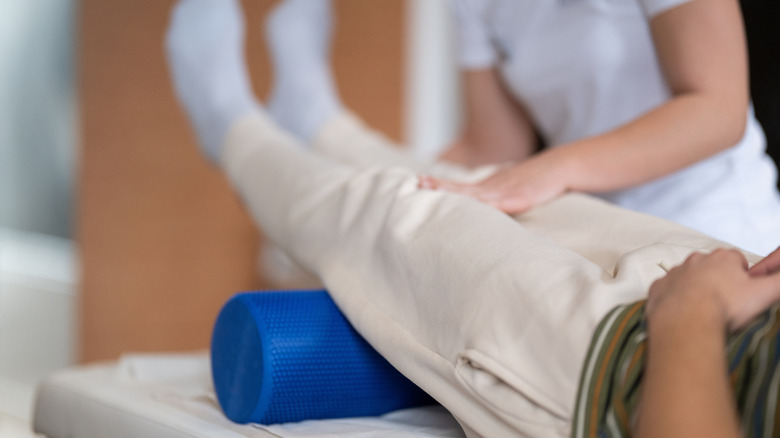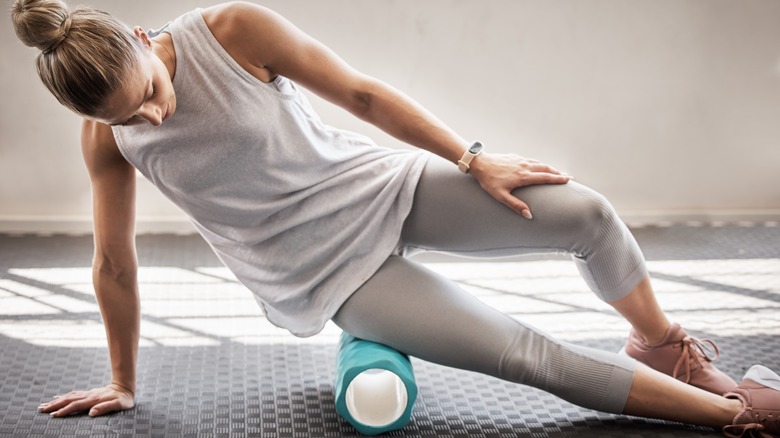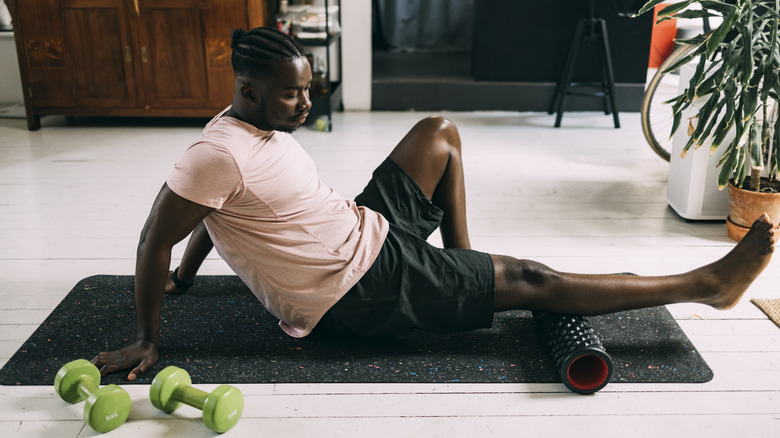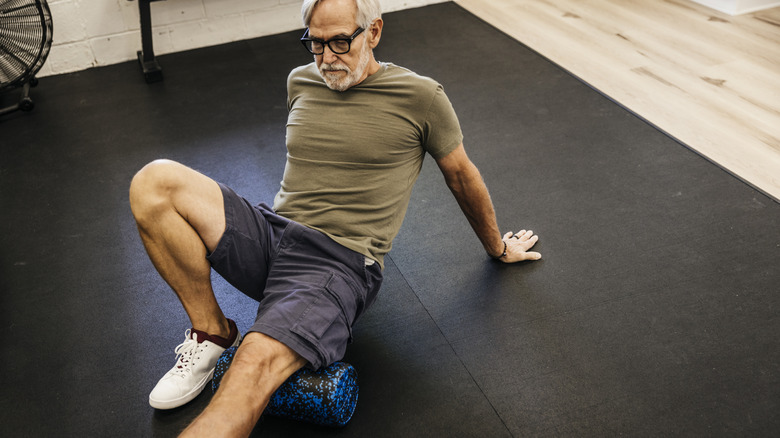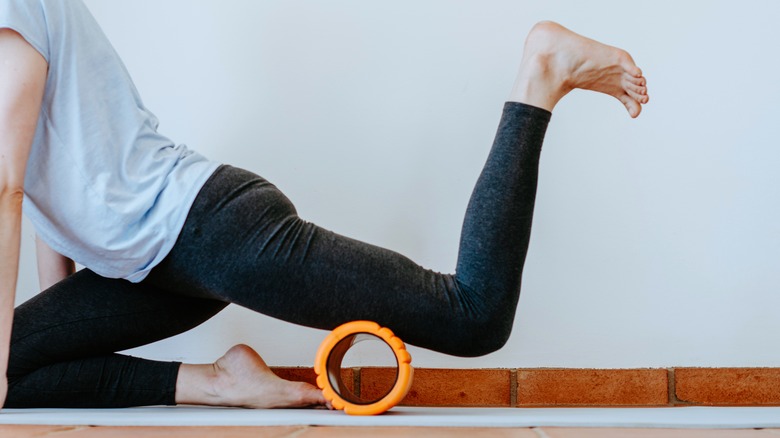The Benefits Of This Popular Workout Recovery Tool Might Be Misleading
In the fitness world, much like with any other activity that goes hand-in-hand with commercialism, new tools can be met with a lot of praise. Whether it's the kettlebell that's lauded for its ability to increase range of motion and build on aerobic power or the massage gun that is thought to relieve muscle soreness and improve blood circulation, the list is pretty endless. Sometimes, however, the merits can be overstated. While we have nothing against tools that make your workouts more effective, some of the claims might be misleading.
In the category of workout recovery tools, it's the foam roller, a self-massaging device that works by using your own body weight to stimulate different regions of your body. Fitness enthusiasts use the foam roller to ease sore muscles after a workout, improve blood circulation, and increase mobility (among other supposed benefits). Typically, you'd place the self-massaging device on the floor, position your body on top of it, and move up and down so you create friction between your body and the roller. "It's comparable to a self-induced massage and gained popularity because it is easy, affordable, and time-efficient," writes certified athletic therapist Mai-Linh Dovan (via Rehab-U). "Yes, it feels good and like anything in the fitness industry, it also became a fad."
One of the top claims for foam rolling is that it can break up scar tissue. Here's why that, and other supposed benefits of this recovery tool, don't make scientific sense.
Foam rolling won't break up scar tissue
One of the more popular benefits attributed to foam rolling is that it can break up adhesions and scar tissue. Experts beg to differ, however.
"[Foam rolling] is just a stimulus to tell your muscle to relax a bit more," explained fitness coach Matthew Jones (via Fit&Well). To start off with, human tissue is not that easy to manipulate. In fact, it's pretty hardy. Doctor of physical therapy Quinn Henoch shared (via Juggernaut Training Systems) that while research on rats showed promise when it came to remodeling tissue by exerting scraping-like pressure on ligaments, the same was not true for experiments on humans. "What we found in fascial tissues, like the [ones in] the deep thigh — very deep thick, fibrous bands, [is that] it takes thousands of pounds of pressure or force to make one percent shear in those tissues," shared the expert.
Foam rollers alone won't improve your mobility or flexibility
While foam rolling can be one facet in the quest to improve mobility, it is not the only one. It is the same principle with flexibility, at least long-term flexibility. As explained by coach and physical therapist John Rusin, as a standalone tool, "the foam roller has very little functional carryover into mobility [and] flexibility."
While there is research to suggest that foam rolling can increase your range of motion, this is just one step in the direction of improving mobility, added Mai-Linh Dovan (via Rehab-U). Your mobility includes other elements too, like motor control and strength. The instant increase in range of motion may make you feel like you've hacked the problem of restricted mobility, but consistently working on all areas concerned is what's going to deliver lasting results.
A 2019 meta-analysis published in Frontiers in Physiology, which included 21 studies (14 that looked at foam rolling as a pre-workout warm-up routine and seven that focused on it as a recovery mechanism), found that foam rolling provided only a small improvement in sprint and flexibility performance and there was a negligible effect on jump and strength activity when it used as a pre-workout tool. The study concluded that a foam roller might be better as a pre-workout tool than a recovery device. Additionally, according to a 2016 study published in the International Journal of Sports Physical Therapy, foam rolling improved flexibility, but only up to 10 minutes post-treatment.
Foam rollers can't make your muscles longer
In addition to the claim that foam rolling as a recovery tool can ease muscle tightness, there is also the idea that it can elongate muscles and make them more pliable. The latter is another myth, per John Rusin.
According to the physical therapist, people might perceive muscle lengthening and pliability because of how foam rollers can increase their range of motion. What is happening, in fact, is that the recovery tool is reducing tension in your muscles and this is giving you more range of motion. Your muscles aren't elongating because of the recovery tool. "Just because a muscle is able to be exerted through further degrees of range of motion does not mean that the reason for the improved range of motion came from said muscle being longer or mechanically changed in any way," explained Rusin. That being said, you can use foam rolling to possibly ease muscle stiffness after a workout.
You can't roll everything using a foam roller
Finally, there's the idea that you can foam roll every body part. However, this might be a classic case of finding relief for a particularly problematic body part while using a recovery tool and then assuming the same can work for all areas.
According to New York-based sports medicine physician and author Dr. Jordan Metzl (via Relax The Back), "The most popular places to use a foam roller are the glutes, lower and upper back, IT band, hamstrings, calves, and quads." What you should be avoiding are the bony bits like the ankles, shins, knees, bony areas on your hips, the bony regions of your pelvis, and your shoulder blades. Your ribs are another area to avoid.
Rolling over bony bits means you're setting yourself up for unnecessary pain that comes from friction between the foam roller and harder body parts. Plus, it's not going to accomplish anything beneficial. You might also cause injury to those areas.
Using foam rollers: A final word
In light of these misleading claims, should you be using foam rollers then? Experts seem to agree that what foam rolling can do is improve your perception of pain, boost blood flow to the areas that are being "massaged," and act as a part of the puzzle when it comes to warm-up, recovery, and fitness. So it's definitely not the worst thing you can possibly do after a workout. Plus, per a 2022 systematic review and meta-analysis published in Sports Medicine, foam rolling, when done for a duration of four weeks or more, could increase muscle and joint-specific range of motion.
That being said, it's important to know how to use the recovery tool correctly and not rely on it to deliver more than it can. Your body and its intricate parts and mechanisms have particular ways of moving and behaving. It might be helpful to dig into those specifics before using any fitness or recovery-related tool. That way you can distinguish between the real health benefits of foam rolling and the misleading ones.
Even though the evidence behind some of the supposed benefits of foam rolling isn't that great, "we can't necessarily ignore the argument of 'it feels good.' ... If people just like doing it because it feels good, we don't have any major reason to stop them," shared musculoskeletal physiotherapist Khalid Maidan (via Clinical Physio). The problem, perhaps, is the fact that there could be a sense of "over-selling" of the recovery mechanism. Some of its benefits have been researched. Some need more data.


